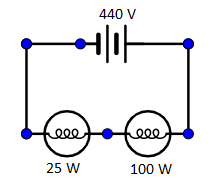
If two bulbs of $25\;{{W}}$ and $100\;{{W}}$ rated at $200\,V$ are connected in $440\,V$ supply, then
(A) $100$ watt bulb will fuse
(B) $25$ watt bulb will fuse
(C) none of the bulb will fuse
(D) both the bulbs will fuse
Answer
142.8k+ views
Hint: The resistance of each bulb will be different hence they have different powers. The voltage across each bulb has to be found using the resistance. Then the result will be compared to the voltage rating of the bulbs. By using the formula of the power, then the solution will be determined.
Complete step by step solution:
Given two bulbs having power, ${P_1} = 25\;{{W}}$ and ${P_2} = 100\;{{W}}$both are rated at voltage, $V = 200\;{{volts}}$ and connected in series with $440$ volts supply.

The expression for power is given as,
$P = \dfrac{{{V^2}}}{R}$
Where, $V$ is the voltage and $R$ is the resistance.
From the above expression,
$R = \dfrac{{{V^2}}}{P}$
Hence, we can find the resistance of each bulb using this equation for the given power and voltage rating.
$ \Rightarrow {R_1} = \dfrac{{{V^2}}}{{{P_1}}} \\
\Rightarrow \dfrac{{{{\left( {200\;{{V}}} \right)}^2}}}{{25\;{{W}}}} \\
\Rightarrow 1600\;\Omega$
The resistance of $25\;{{W}}$ bulb is $1600\;\Omega $.
And,
$\Rightarrow {R_2} = \dfrac{{{V^2}}}{{{P_2}}} \\
\Rightarrow \dfrac{{{{\left( {200\;{{V}}} \right)}^2}}}{{100\;{{W}}}} \\
\Rightarrow 400\;\Omega$
The resistance of $100\;{{W}}$ is $400\;\Omega $.
Since the two bulbs are connected in series, the total resistance will be ${R_1} + {R_2}$.
The voltage across each bulb will be different. They are connected to $440$ volts supply also.
Hence, the voltage across the $25\;{{W}}$ bulb is given as,
$\Rightarrow {V_1} = 440\;{{V}} \times \dfrac{{{R_1}}}{{{R_1} + {R_2}}}$
Substituting the values in the above expression,
$\Rightarrow {V_1} = 440\;{{V}} \times \dfrac{{1600\;\Omega }}{{1600\;\Omega + 400\;\Omega }} \\
\Rightarrow 352\;{{V}}$
The voltage across $25\;{{W}}$ is $352\;{{V}}$. This is higher than the rated voltage $200\;{{volts}}$. Therefore, the bulb will fuse.
The voltage across $100\;{{W}}$ bulb is given as,
$\Rightarrow {V_2} = 440\;{{V}} \times \dfrac{{{R_2}}}{{{R_1} + {R_2}}}$
Substituting the values in the above expression,
$\Rightarrow {V_2} = 440\;{{V}} \times \dfrac{{400\;\Omega }}{{1600\;\Omega + 400\;\Omega }} \\
\Rightarrow 88\;{{V}} $
The voltage across $100\;{{W}}$ is $88\;{{V}}$. This is lower than the rated voltage $200\;{{volts}}$. Therefore, the bulb will not fuse.
Therefore, only the $25\;{{W}}$ bulb will fuse.
The answer is option B.
Note: If two bulbs have the same voltage rating but the power is different, then a bulb having high power will have low resistance. And the low power bulb will fuse than the high power bulb. The power is directly proportional to the square of the voltage and inversely proportional to the resistance.
Complete step by step solution:
Given two bulbs having power, ${P_1} = 25\;{{W}}$ and ${P_2} = 100\;{{W}}$both are rated at voltage, $V = 200\;{{volts}}$ and connected in series with $440$ volts supply.

The expression for power is given as,
$P = \dfrac{{{V^2}}}{R}$
Where, $V$ is the voltage and $R$ is the resistance.
From the above expression,
$R = \dfrac{{{V^2}}}{P}$
Hence, we can find the resistance of each bulb using this equation for the given power and voltage rating.
$ \Rightarrow {R_1} = \dfrac{{{V^2}}}{{{P_1}}} \\
\Rightarrow \dfrac{{{{\left( {200\;{{V}}} \right)}^2}}}{{25\;{{W}}}} \\
\Rightarrow 1600\;\Omega$
The resistance of $25\;{{W}}$ bulb is $1600\;\Omega $.
And,
$\Rightarrow {R_2} = \dfrac{{{V^2}}}{{{P_2}}} \\
\Rightarrow \dfrac{{{{\left( {200\;{{V}}} \right)}^2}}}{{100\;{{W}}}} \\
\Rightarrow 400\;\Omega$
The resistance of $100\;{{W}}$ is $400\;\Omega $.
Since the two bulbs are connected in series, the total resistance will be ${R_1} + {R_2}$.
The voltage across each bulb will be different. They are connected to $440$ volts supply also.
Hence, the voltage across the $25\;{{W}}$ bulb is given as,
$\Rightarrow {V_1} = 440\;{{V}} \times \dfrac{{{R_1}}}{{{R_1} + {R_2}}}$
Substituting the values in the above expression,
$\Rightarrow {V_1} = 440\;{{V}} \times \dfrac{{1600\;\Omega }}{{1600\;\Omega + 400\;\Omega }} \\
\Rightarrow 352\;{{V}}$
The voltage across $25\;{{W}}$ is $352\;{{V}}$. This is higher than the rated voltage $200\;{{volts}}$. Therefore, the bulb will fuse.
The voltage across $100\;{{W}}$ bulb is given as,
$\Rightarrow {V_2} = 440\;{{V}} \times \dfrac{{{R_2}}}{{{R_1} + {R_2}}}$
Substituting the values in the above expression,
$\Rightarrow {V_2} = 440\;{{V}} \times \dfrac{{400\;\Omega }}{{1600\;\Omega + 400\;\Omega }} \\
\Rightarrow 88\;{{V}} $
The voltage across $100\;{{W}}$ is $88\;{{V}}$. This is lower than the rated voltage $200\;{{volts}}$. Therefore, the bulb will not fuse.
Therefore, only the $25\;{{W}}$ bulb will fuse.
The answer is option B.
Note: If two bulbs have the same voltage rating but the power is different, then a bulb having high power will have low resistance. And the low power bulb will fuse than the high power bulb. The power is directly proportional to the square of the voltage and inversely proportional to the resistance.
Recently Updated Pages
How to find Oxidation Number - Important Concepts for JEE

How Electromagnetic Waves are Formed - Important Concepts for JEE

Electrical Resistance - Important Concepts and Tips for JEE

Average Atomic Mass - Important Concepts and Tips for JEE

Chemical Equation - Important Concepts and Tips for JEE

Concept of CP and CV of Gas - Important Concepts and Tips for JEE

Trending doubts
JEE Main Exam Marking Scheme: Detailed Breakdown of Marks and Negative Marking

Electrical Field of Charged Spherical Shell - JEE

JEE Main Chemistry Question Paper with Answer Keys and Solutions

Geostationary Satellites and Geosynchronous Satellites - JEE Important Topic

Charging and Discharging of Capacitor

JEE Main 2025: Conversion of Galvanometer Into Ammeter And Voltmeter in Physics

Other Pages
JEE Advanced 2025: Dates, Registration, Syllabus, Eligibility Criteria and More

Explain the construction and working of a GeigerMuller class 12 physics JEE_Main

The perfect formula used for calculating induced emf class 12 physics JEE_Main

Introduction to Dimensions With Different Units and Formula for JEE

JEE Advanced 2025 Revision Notes for Practical Organic Chemistry

A Zener diode having breakdown voltage equal to 15V class 12 physics JEE_Main




